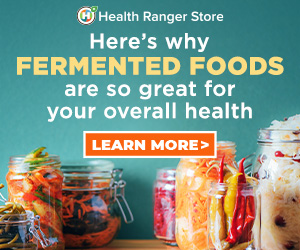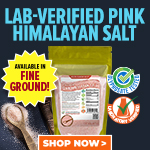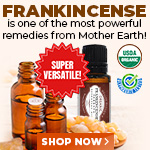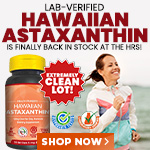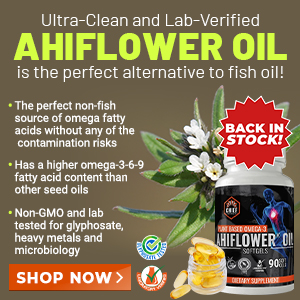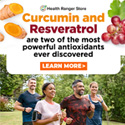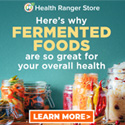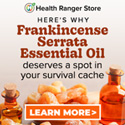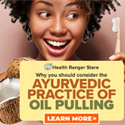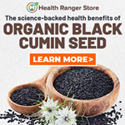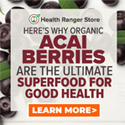
Plant-Based Diets: An Overview of Options for Optimal Health
Tuesday, August 12, 2008 by: Mary Laredo
Tags: plant-based diet, health news, Natural News
- Pfizer faces legal backlash: Texas, Kansas, and more states begin to challenge Prep Act Immunity Shield
- Maple syrup: Nature's golden superfood and its sweet health benefits
- Manufacturing surge under Trump sparks optimism amid concerns over economic strains
- Florida sky mystery: Toxic heavy metals and bioengineered particles found in air and food samples
- Possible biosignatures detected on Exoplanet K2-18b, raising hopes for alien life
- Omega-3s: a powerful ally in the fight against chronic inflammation
- Aerosolized bioweapons? Strange “diploid biomasses” falling out of the sky in Florida captured under the microscope
- HHS Secretary Kennedy will likely investigate the following environmental exposures as CAUSES OF AUTISM and brain damage in children
- U.S. demands U.K. protect FREE SPEECH, repeal hate speech authoritarianism, in latest trade deal negotiations
- Controversy over $400K fund for Texas killer's family sparks outrage: Legal, ethical questions emerge
- Russia escalates censorship war, targets over 200 VPN apps amid Google resistance
- Majority of Americans now favor mass deportation of illegal immigrants, polls show shift in public sentiment
- Analysis: The coming economic collapse, a mass uprising and Trump's three secret weapons to halt the growing revolt
- Trump's bold trade overhaul reaches a crossroads with Italy, as "fair deals" promise sparks global attention
- TAKE IT DOWN Act advances in Congress amid free speech concerns
- Mike Adams releases country western hit single: Goin’ Back in Time is Comin’ Home
- Cruciferous vegetables deliver TRIPLE the heart benefits than previously known, study reveals
- Kava: The Pacific's healing wonder
- Aerosolized bioweapons? Strange “diploid biomasses” falling out of the sky in Florida captured under the microscope
- Analysis: The coming economic collapse, a mass uprising and Trump's three secret weapons to halt the growing revolt
- Widespread social and economic unrest: Steve Quayle issues urgent financial warning of imminent asset collapse in new interview with Mike Adams
- TAKE IT DOWN Act advances in Congress amid free speech concerns
- Israeli lobbyists boast of controlling US national security policy in leaked AIPAC audio
- Kiss Your Genetic Privacy Good-Bye! 23andMe Gets Green Light to Sell Your Intimate Genetic Details to Anyone They Want
- Mike Adams releases country western hit single: Goin’ Back in Time is Comin’ Home
- U.S. lawmakers investigate Meta over alleged China collaboration
- CLOT SHOT PLANDEMIC UNFOLDING: Fibrous, rubbery clots caused by covid injections have prion-like seeding activity
- Fauci is back in the limelight, and he’s busy promoting a future COVID or FLU pandemic
- Defunding DEADLY mRNA jabs: Government funding for mRNA technology being scrutinized and sidelined until proven "safe and effective" for real
- Russia escalates censorship war, targets over 200 VPN apps amid Google resistance
- Curcumin’s ancient healing power supercharges muscle recovery, and its effects are compounded with anti-inflammatory foods and supplements
- I Want My Bailout Money – new song and music video released by Mike Adams
- I Want My Bailout Money – new song released by Mike Adams
- Government waste exposed: Hegseth supports Musk’s demand for accountability from federal workers
- U.S. approves new Russian ambassador as diplomatic thaw continues
- Federal employees whine over DOGE's new directive requiring them to do a 5-point summary of weekly accomplishments
- Newly released JFK files reveal Pentagon's role in creating Lyme disease and covid in the same lab
- Analysis: The coming economic collapse, a mass uprising and Trump's three secret weapons to halt the growing revolt
- Aerosolized bioweapons? Strange “diploid biomasses” falling out of the sky in Florida captured under the microscope
- Kiss Your Genetic Privacy Good-Bye! 23andMe Gets Green Light to Sell Your Intimate Genetic Details to Anyone They Want
- Mike Adams releases country western hit single: Goin’ Back in Time is Comin’ Home
- European Court of Justice: Healthcare professionals who promoted or administered COVID-19 vaccines are CRIMINALLY LIABLE for any harm caused
- Widespread social and economic unrest: Steve Quayle issues urgent financial warning of imminent asset collapse in new interview with Mike Adams
- Federal employees whine over DOGE's new directive requiring them to do a 5-point summary of weekly accomplishments
- U.S. approves new Russian ambassador as diplomatic thaw continues
- CLOT SHOT PLANDEMIC UNFOLDING: Fibrous, rubbery clots caused by covid injections have prion-like seeding activity
- Government waste exposed: Hegseth supports Musk’s demand for accountability from federal workers
- I Want My Bailout Money – new song and music video released by Mike Adams
- I Want My Bailout Money – new song released by Mike Adams
- Fauci is back in the limelight, and he’s busy promoting a future COVID or FLU pandemic
- Defunding DEADLY mRNA jabs: Government funding for mRNA technology being scrutinized and sidelined until proven "safe and effective" for real
- Trump administration poised to overhaul crypto regulations with new SEC leadership
- Now you can HEAR chemistry: Health Ranger translates molecules into music in stunning video demonstration that will blow your mind (and your ears)
- South Carolina Congressman proposes new $250 bill and wants Trump on the front
- Red Cross issues warning to stop blood plasma donations from vaccinated people
- Scientists confirm: GENIUS brain function can be spontaneously unleashed in humans without any apparent cause
- EPA advisor admits the agency is funneling billions to climate groups ahead of Trump’s return to White House
- HYSSOP: What research reveals about the health benefits of this ancient holy herb
- Two containers with completed ballots fall out of truck in Florida
- Newly released JFK files reveal Pentagon's role in creating Lyme disease and covid in the same lab
- Mike Adams releases country western hit single: Goin’ Back in Time is Comin’ Home
- Global leaders unite to clamp down on “misinformation” with UN-backed Cascais Declaration
- BREAKING: 2025 NDAA authorizes mandatory military draft of WOMEN across America… as Pentagon pursues global NUCLEAR war with both Russia and China at the same time
- I Want My Bailout Money – new song released by Mike Adams
- Michael Yon warns of a ZIONIST TAKEOVER in Trump’s second administration
- The Health Ranger releases “Vaccine Zombie” song and music video, using AI-animated zombies for the music video
- Ozempic and Wegovy weight loss drugs are injectable LIZARD VENOM PEPTIDES that may unleash a devastating wave of organ failure… side effects align with symptoms of SNAKE BITES
- BOMBSHELL: DNA testing kits are a SCAM to develop ethnic-specific bioweapons
- Israeli soldiers accused of even more torture and abuse in the West Bank
- These 13 countries just signed an agreement to engineer a global FAMINE by destroying food supply
- RFK Jr. clears key hurdle: Sen. Susan Collins backs controversial HHS nominee, signaling a new era for health policy
- NASA admits that climate change occurs because of changes in Earth’s solar orbit, and NOT because of SUVs and fossil fuels
Protein is made up of amino acids -– the "building blocks" with which our bodies construct and repair tissue. Among the twenty or so different amino acids are at least eight which are considered essential because they must be obtained from foods.
Animal sources –- especially beef –- are commonly thought to be the most efficient means of obtaining the nutrient since they provide "quality" proteins similar to human flesh and contain all of the essential amino acids. In the recent past it was believed that each daily meal should include complete proteins –- containing all the amino acids, and even though science has since disproved this notion, the misconception persists. This has led to an over consumption of animal protein in most western diets and the mistaken belief that plants are an inferior source of the coveted nutrient.
Protein is responsible for tissue development. Growing infants, among all humans, have the highest requirement of the nutrient. Approximately 6% of the calories in mother's milk come from protein, which adequately meets the infant's needs (1). A wealth of research indicates that more than 10% of calories from protein –- especially when the bulk of it is from animal sources –- leads to many chronic illnesses, including cancer. On average, Americans consume more than this amount, yet a collective fear of not getting enough "quality" protein persists.
Virtually all plant food provides protein, in addition to their other health benefits. In his essential book The China Study, T. Colin Campbell, PhD. discloses undisputed evidence that plant protein is the healthiest source of this nutrient.
With heart disease, cancer and diabetes on the rise many individuals have discovered the health benefits and wisdom of a plant-based diet. As they seek healthier lifestyles however, they may be confused by conflicting information and surprised by the various options to the Standard American Diet.
The Plant-Based Diet Spectrum
Among the many plant-based diets that have helped individuals reverse chronic illness and disease are the macrobiotic; natural foods; fruitarian; raw foods; vegetarian; vegan, raw vegan and low-fat raw vegan diets. This report will not give space to any of the calorie reducing, nutritionally unsound fad diets such as the Atkins and the South Beach.
Knowledge of the various plant-based diets' basic aspects is necessary before deciding which is best for one's health and healing. Further individual research and application is the only way to determine which diet will be most feasibly incorporated into one's lifestyle.
Macrobiotic
Whole grains, green leafy vegetables and root vegetables –- primarily locally grown –-
are the bases of the macrobiotic diet. Soybean products and other beans are consumed often, if not daily. Among the occasional foods are fruit; seeds and nuts; fermented condiments; sea vegetables, and fish which are typically consumed two or three times per week. Beef, poultry, dairy products, sugar and processed foods are avoided.
Macrobiotic meals are combined with the principals of balance in mind, with consideration of season, climate, gender and the general health of the individual. Natural foods are preferred over refined foods, and light foods are favored over heavy foods that drain the body of energy.
This low-fat, high fiber diet involves careful planning and provides many health benefits, at least in the short term. Opponents suggest that the diet is too restrictive and results in nutritional deficiencies over time. While there are numerous accounts of healing from cancer by following a macrobiotic diet, several long-term practitioners, teachers and authors espousing the lifestyle have ironically succumbed to the disease (2).
Natural Foods
A diet that includes fresh fruits, vegetables and other whole foods while eliminating or severely restricting processed foods is considered a natural foods diet. Refined grains; sugar; table salt; carbonated beverages; hydrogenated oils; chemical additives, and food coloring are considered harmful to the body and are generally avoided. Healthier choices include whole grains; honey; herbal teas; olive oil; sea salt and culinary herbs and spices. Wild or ocean-caught fish as well as pasture-fed beef and poultry are preferred over the factory-farmed varieties.
Clearly, a natural foods diet provides superior nourishment than the Standard American Diet and is useful for health maintenance and disease prevention; however, it is not considered a cleansing diet. When optimal health is the goal, or if a life-threatening disease occurs, a more restrictive diet may be necessary to allow the body to cleanse and heal itself.
Fruitarian
The original human diet seems likely to have been one consisting solely of fruits, and this concept is the basis of the fruitarian philosophy. Fruitarians maintain a diet of whole raw fruits, including the non-sweet varieties such as cucumbers, tomatoes and avocados, and embrace this diet and lifestyle as the most natural to our existence. Unlike other natural food sources, fruit is harvested without killing the plant and is therefore considered by the fruitarian to be the most sustainable, natural and humane diet.
The purist consumes only raw fruit and believes that the consumption of nuts, seeds and grains are unnatural, although some fruitarians include small amounts of these foods in their diets. A fruitarian diet is extremely cleansing and useful for short-term detoxification; however, existing solely on fruit for the long-term may be difficult and detrimental to health as some practitioners eventually experience severe food cravings and unpleasant symptoms signaling nutritional deficiencies.
Vegetarian and Vegan
Many individuals opt for a vegetarian or vegan diet due to health, concern for animals and the environment, and/or philosophical reasons. A vegetarian diet excludes all animal flesh but does not restrict animal by-products. For instance, a lacto-ovo vegetarian eats dairy and eggs while refraining from meat. A vegan diet on the other hand excludes all animal products, including honey. There are no restrictions from any of the other food groups, nor are their limitations on the method of food preparation. Food may be raw, cooked, whole or processed.
Simply eliminating meat, fish and animal by-products does not necessarily ensure good health; in fact, many vegetarians regularly consume a high-fat, highly processed diet of refined grains, sugar, coffee, alcohol and other empty calorie foods. However, the vegetarian and vegan diet is conducive to good health when it consists of a wide variety of natural foods. According to the American Dietetic Association and Dietitians of Canada "appropriately planned vegetarian diets are healthful, nutritionally adequate and provide health benefits in the prevention and treatment of certain diseases".
Vegetarians run the risk of developing a vitamin B-12 deficiency since plant foods don't provide adequate amounts of this essential nutrient. Among its many functions B-12 is responsible for growth in children, a healthy nervous system, and the formation of red blood cells. Prolonged deficiencies may lead to anemia and neurological damage.
Spirulina and sea vegetables are thought to contain B-12, yet studies show that these food sources actually contain a form that is structurally similar to B-12 (a B-12 analog), which is not utilized by the body and may in fact compete with the vitamin for absorption (3).
Vitamin B-12 is made by microorganisms in the soil, (as well as in animal intestines), and research indicates that plants will absorb the vitamin if grown in healthy organic soil containing a concentration of B-12 (4). Nevertheless, to avoid the possible risk of a deficiency, vegetarians and vegans should have their levels checked periodically and supplement with a sublingual form of methylcobalamin, if necessary.
Raw Foods
Any diet that excludes cooked animal or plant food is considered a raw foods diet. Cooking food at high temperatures reduces its nutrient value and destroys enzymes that would otherwise aid the body in the digestion and absorption of food. Common practices among raw foodists include warming, drying, and dehydrating food up to approximately 115 degrees Fahrenheit as this low heat will not compromise enzyme activity. Countless studies have revealed that cooking food produces toxic by-products, and once consumed, the body reacts by generating white blood cells to attack the foreign debris.
Raw Vegan Diets
In 1878, Louis Pasteur published his "germ theory of disease" which led to the widespread fear of germs and the popular belief that all foods must be cooked to protect health (1). Diets that once contained very little cooked food and an abundance of fresh, raw fruits and vegetables were switched to a predominance of cooked food. Today the concept of a high raw diet is foreign to most people, although it continues to regain popularity and credibility as its advocates and practitioners increase globally and exponentially.
A raw food diet may contain fish, eggs, unpasteurized milk and other raw animal products; however, a raw vegan shuns all animal flesh and by-products in favor of raw fruits, vegetables, (including seaweeds), sprouts, juices, herbs, nuts, seeds and their unprocessed oils.
Raw vegan preparations often include dehydrated and fermented foods. Fat content can be extremely high on a raw vegan diet when nuts, seeds, avocados and oils comprise the largest percentage of calorie intake.
80-10-10 Raw Diet
The low-fat raw vegan diet known as the 80-10-10 diet is thoroughly explained in the book by the same name, written by Dr. Douglas Graham. The numbers refer to the recommended ratio of carbohydrates, proteins and fats in the diet. Graham, who has followed this lifestyle for nearly thirty years, asserts that a minimum of 80% of total caloric intake should come from carbohydrates, a maximum of 10% from protein and up to 10% from fat. The concept may seem radical and unacceptable to many but it nevertheless takes the raw vegan diet to the next level of health.
With science to back him up Graham makes a convincing case for a diet of whole, fresh, ripe, raw and unprocessed fruit, tender greens, and small amounts of nuts and seeds, as the most natural to our anatomy, physiology and biochemistry. If left to fend for ourselves in nature with our bare hands and without the convenience of stoves, utensils, refrigeration and other modern devices we would seek out and thrive on this dietary model.
Fruit sugar provides energy to cells within a matter of minutes as long as there is a relatively small amount of fat in the diet. Without excess fat to slow it down, the natural sugar travels easily from the digestive tract through the intestinal wall and into the bloodstream where it then makes its way to nourish cells.
Fats on the other hand take twelve to twenty-four hours to finally reach the cells. An excess consumption causes the bloodstream to remain congested with fat which in turn slows sugar from reaching the cells. The resultant elevated blood sugar contributes to candida, diabetes and many other illnesses.
Excess dietary fat (more than 10% of total caloric intake), not natural sugar, is the offender as it holds up digestion and adversely affects blood sugar levels. According to Graham, high fat intake "contributes not peripherally, but directly and causally to all the misleadingly named 'blood-sugar metabolic disorders.'
Graham maintains that fruit is the most nutritionally-complete food and should be the basis of a healthy diet. Vegetable fruits (cucumbers, tomatoes, etc.) and tender greens are also cleansing and alkalizing, and are an important component of the 80-10-10 diet as well.
Transition
For most people addicted to the Standard American Diet the transition to any one of the healing diets may be difficult. Instead of eliminating foods it may be easier to initially begin adding raw vegetables and fruits to one's daily diet. This may take a period of several days or weeks, but once this has become habit some of the health-damaging foods may be easier to release. The next level might be a natural foods diet before attempting a further restrictive cleansing diet. The strategy is to follow an incremental path to the optimum dietary lifestyle, regardless of how long it takes.
Many chronically ill individuals have made their transitions literally overnight in an effort to end their suffering or save their lives. These individuals endured the symptoms of detoxification until finally arriving at renewed health, and many have subsequently published their remarkable accounts of healing. Among the scores of noteworthy testimonies are The Raw Family: A True Story of Awakening by Victoria, Igor, Sergei and Valya Boutenko, (http://rawfamily.com/index) , A Way Out by Matthew Grace, (http://www.matthewgrace.com) , and Dying to Get Well by Shelly Keck-Borsits (http://www.rawandjuicy.com) .
Transitioning to a plant-based diet for optimum health is a lifestyle adjustment rather than a temporary phase, and determining the best option is an individual investigation that takes time. We tend to eat for reasons having less to do with nutrition and more to do with comfort, emotional attachment and tradition, and it's been said that changing one's diet is more difficult than changing religions. Nevertheless, once the addictive and highly processed foods are eliminated and the restorative powers of healing foods are realized it becomes easier and more desirable to stay the course.
References:
1. Graham, Dr. Douglas N.: The 80-10-10- Diet. Key Largo, FL: FoodnSport Press,
pp. 100; pg. 106; pg. 54, 2006
2. (http://macrobiotics.co.uk/foodlist.htm)
3. (www.vegsoc.org/info/b12.html)
4.Campbell, PhD., T. Colin and Campbell II,Thomas M.: The China Study. Dallas, Texas: Benbella Books, pg. 232. 2006
About the author
Mary Laredo is an artist, educator and gallery curator who lives and works in Detroit, MI. As a breast cancer survivor who shunned conventional treatment, she is writing a book about her experience with natural therapies and nutritional healing. Visit http://marylaredo.blogspot.comPlant-based diet at FETCH.news
Get independent news alerts on natural cures, food lab tests, cannabis medicine, science, robotics, drones, privacy and more.
Take Action: Support Natural News by linking to this article from your website
Permalink to this article:
Embed article link: (copy HTML code below):
Reprinting this article:
Non-commercial use OK, cite NaturalNews.com with clickable link.
Follow Natural News on Facebook, Twitter, Google Plus, and Pinterest
Science News & Studies
Medicine News and Information
Food News & Studies
Health News & Studies
Herbs News & Information
Pollution News & Studies
Cancer News & Studies
Climate News & Studies
Survival News & Information
Gear News & Information
News covering technology, stocks, hackers, and more



"Big Tech and mainstream media are constantly trying to silence the independent voices that dare to bring you the truth about toxic food ingredients, dangerous medications and the failed, fraudulent science of the profit-driven medical establishment.
Email is one of the best ways to make sure you stay informed, without the censorship of the tech giants (Google, Apple, Facebook, Twitter, YouTube, etc.). Stay informed and you'll even likely learn information that may help save your own life."
–The Health Ranger, Mike Adams










